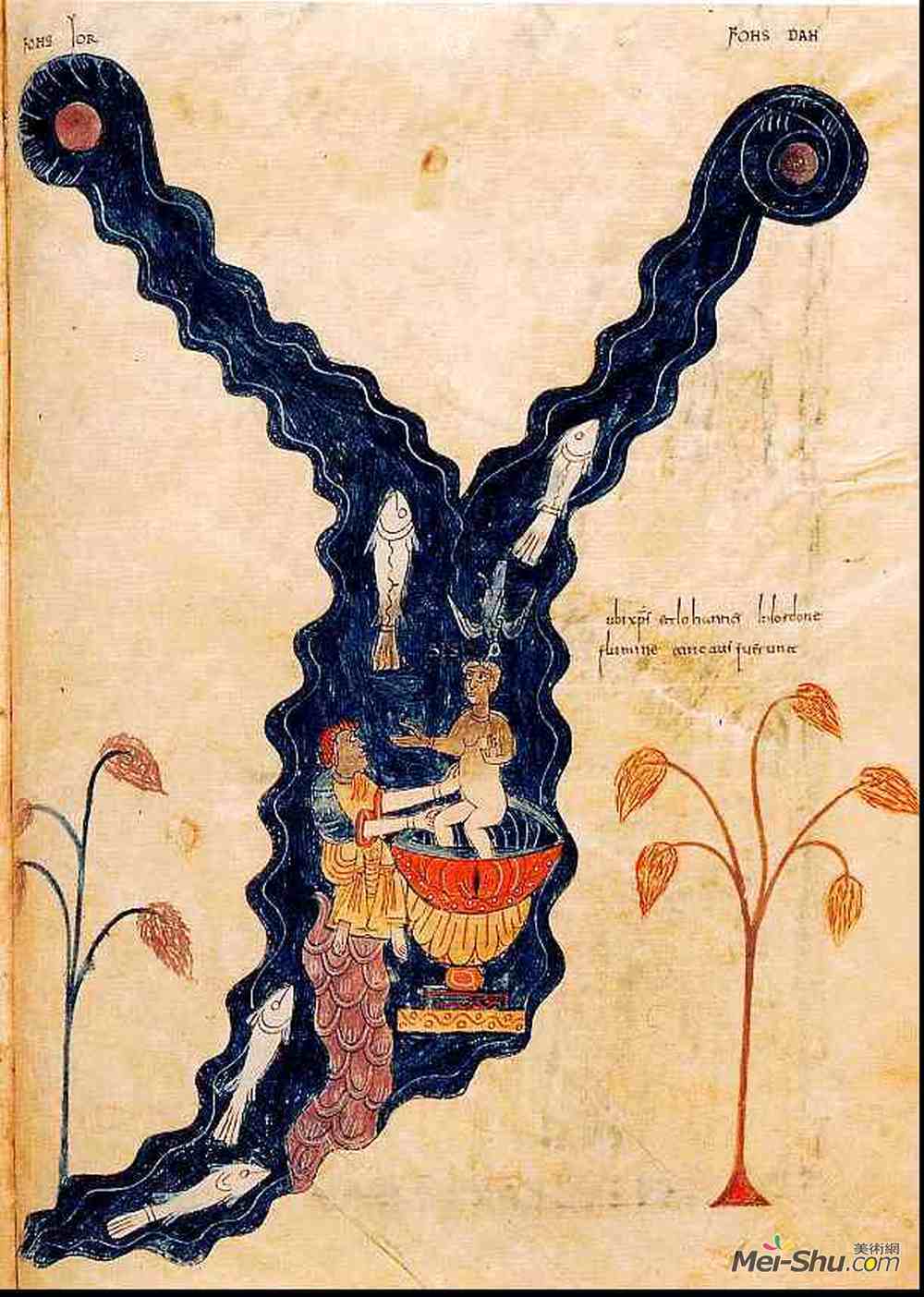 恩德(Ende)高清作品《耶稣基督的洗礼》
恩德(Ende)高清作品《耶稣基督的洗礼》
作品名:耶稣基督的洗礼
艺术家:恩德
年代:c.975
风格:莫札拉布
类型:微型
<> P> GeONA BeaTeas,除了都灵BeaSt之外,是唯一一个现存的BeaTube,其特征是位于Sion山上的羊羔座的末端(Rev)。14:1-5)在绘画之前的页面上,说明了这一部分。它没有框架,如通常不属于启示的主题,并涵盖整个开本。在上图中描绘的是约旦的两个来源,通常是圆形的,左边的是“Fon Yor”,右边是“Fon D丹”。每一条水道都有波浪形的面,都是鱼,然后合并成一个有耶稣基督的洗礼字体,可能代表一个赤裸的孩子在里面。在他头顶上方是圣灵,以鸽子的形式,带有“sp [皮里图]”的传说,而圣约翰则以脚踝长,萨克多尔长袍代替骆驼皮,显示在左边的岩石上,被身体和右腿抓住,从而表明它是一种洗礼。浸泡。无论是上帝还是先驱都没有一个光环,这暗示着与一个非常古老的模型的联系。在景色下面和两旁是另外两条鱼和两棵树,它们象征着约旦多叶的河岸,右边写着“乌比xpi和碘化钾/碘化钾”。图像的意义是双重的,既是福音派的,代表了两个人物和河中圣灵的鸽子,也包括圣礼,包括那个时期典型的礼拜仪式元素,如洗礼字体和圣约翰的牧师长袍。关于第一个方面,基督的洗礼包括两个要素:净化河水和神像。至于圣礼的性质,在莫扎拉自由法令中,教友们等待浸入式洗礼的地方被称为阿格尼勒;同样,纳粹的圣格雷戈里称之为天堂礼仪的前厅。继续洗礼字体对约旦的礼仪含义,莫扎拉自由法令规定它必须充满河水。此外,自三世纪以来,Hispania的儿童洗礼记录在案。有基督的形象被洗礼的字体可以追溯到早期基督教和中世纪早期。这一切都可能与上帝羔羊救赎的观念有关,因此这个形象在启示录中可以被认为是“Hii emti sunt ab initjo/d[e]o et agno”(f.188v.)的光泽。14:4或者,更可能的是,作为泰科尼乌斯对这段话的解释的例证,正如在Beatus的序言中所看到的:“cantant canticu[m]nobu[m]id est/predicant xpm[…]p[er]babtism[m]et penitentja[m]/.ssionem om[n]ium peccator[um]”(f.26v)。
Title:The baptism of Christ
artist:Ende
Date:c.975
Style:Mozarabic
Genre:miniature
The Gerona Beatus is, apart from the Turin Beatus, the only extant Beatus to feature this illustration, which is situated at the end of the storia about the Lamb upon Mount Zion (Rev. 14: 1-5) on the page preceding the painting that illustrates this section. It has no frame, as is usual in themes not belonging to the Revelation, and covers the entire folio. Depicted in the upper part are the two sources of the Jordan, in the usual, circle form – the left-hand one reading “FONS YOR” and the right-hand one “FONS DAN”. A water course emerges from each one with wavy sides –both with a fish– which then merge into one where there is a baptismal font with Christ, possibly represented as a naked child inside. Situated above his head is the Holy Ghost, in the form of a dove, with the legend “SP[PIRITU]S”, whilst St John garbed in ankle-length, sacerdotal robes instead of his camel skin, is shown on a rock to the left grasping Christ by the body and right leg, thereby revealing that it is a baptism by immersion. Neither the Lord nor the Precursor have a nimbus, which could suggest a link with a very ancient model. Underneath and flanking the scene are another two fish and two trees that symbolise the leafy banks of the Jordan, with the words “ubi xpi et iohannes in iordone/flumine tinctus fuerunt” to the right. The meaning of the image is twofold, being both evangelical, with the representation of the two figures and the dove of the Holy Ghost in the river, and sacramental, by including liturgical elements typical of that period, such as the baptismal font and St John’s priestly robes. As regards the first aspect, the Baptism of Christ consists of two elements: the purification of the river water and the theophany. As for the sacramental nature, the place where the catechumens await their baptism by immersion is called agnile in the Mozarabic Liber Ordinum; similarly, St Gregory of Nazianzus called it the antechamber of the heavenly liturgy. Continuing with the liturgical implications of the baptismal font upon the Jordan, the Mozarabic Liber Ordinum specifies that it must be filled with river water. In addition, the baptism of children has been recorded in Hispania since the 3rd century. There are images of Christ being baptised in a font dating back to Early Christian and early medieval times. All this is possibly linked to the notion of the redemption made by the Lamb of God, hence this image may be deemed to be a gloss of “Hii emti sunt ab initjo/d[e]o et agno” (f. 188v.) in Rev. 14: 4 or, more probably, as an illustration of Tyconius’s interpretation of this passage, as can be seen in the preface by Beatus: “cantant canticu[m] nobu[m] id est/predicant xpm [...] p[er] babtism[um] et penitentja[m]/remissionem om[n]ium peccator[um]” (f. 26v).
作品链接:https://www.mei-shu.com/famous/27440/artistic-123905.html
作品类别:油画
免责声明:本站部分公开资料来源于互联网,目的是用于学术交流与讨论,并不代表本网赞同其观点和对其真实性负责。如果您认为我们的侵犯了您的权益,请与我们联系(banquan#mei-shu.com #替换为@),我们将在第一时间删除相关内容。